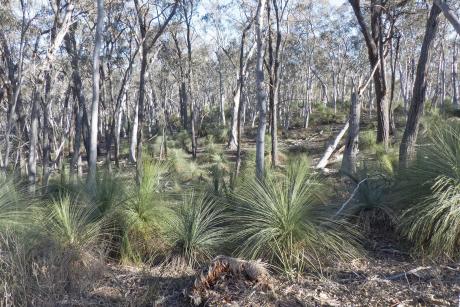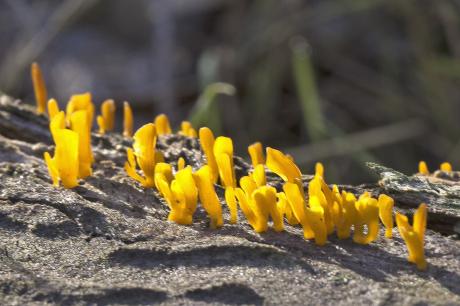Livingstone – a Winter Walk

 A forecast of a cold foggy morning did not deter four of us as we met at Glenn’s place for the Livingstone Forest excursion. We travelled in one car to the advertised meeting place at the Uranquinty Bakery. Despite being foggy all the way, Nella found that by keeping the speed down as did all the other drivers on the road, the driving wasn’t at all onerous. We had allowed for slower travel and in fact arrived at the Bakery with 10 minutes before the meeting time of 9am. Naturally we waited for others to turn up with a coffee.
A forecast of a cold foggy morning did not deter four of us as we met at Glenn’s place for the Livingstone Forest excursion. We travelled in one car to the advertised meeting place at the Uranquinty Bakery. Despite being foggy all the way, Nella found that by keeping the speed down as did all the other drivers on the road, the driving wasn’t at all onerous. We had allowed for slower travel and in fact arrived at the Bakery with 10 minutes before the meeting time of 9am. Naturally we waited for others to turn up with a coffee.
Encouraged by the friendly service – advising us to sit at the warmest table – we waited until 9:30 before continuing on minus more company. Approaching the National Park we encountered gaps in or rose above the fog. In one of the gaps Nella spotted a number of Flame Robins scattered along the roadside fences. Thoughts were that we should see more in Livingstone.
Arriving at the park entrance we were greeted by Marcus Wright, the Regional Project Officer, Biodiversity Reforms for Riverina Eastern Regional Organisation of Councils (REROC). He was there organising a 16th birthday camping experience for a small group of boys. Marcus gave us an insight into the operations of the New Biodiversity Act and its implications for land clearing and the offsets required. He offered to give us a talk one evening if we provide him some questions first (subject to his bosses approval).
It was more like ten when we started walking but we did not get far before stopping to admire the Spreading Wattle Acacia genistifolia in full blossom.
The bird list was beginning to grow as well.
The walking track from the entrance takes a well graded route up one side of a valley to near the saddle and then back down the other side. It is a shared route – bicycles and horse riding are permitted so there are no rough bits. It may have been a shared route but we had it all to ourselves.
Being midwinter there were not many flowers out and as we gained in height the bird life decreased. Nevertheless there were plenty of orchid leaves around and other plants not usually seen by us but unfortunately not in flower. So much temptation for another visit later in the year. Moreover there was sunshine for the whole time we were there – idyllic walking conditions.
It was around one when we got back to the car for lunch. The camping party had left so it was pleasant sitting in the sun to eat and watch the antics of a few friendlier birds forage just a little distance from us. Unfortunately they did not include the mixed group of Red-browed and Diamond Finches we had great pleasure in observing soon after starting the walk.
All was peaceful until we had finished eating when a gun club member began practising at the adjacent shooting range. The first shot made us jump, but not the birds – they took no notice at all.
Instead of back tracking to Uranquinty, we took the drive through the park right through the southern end. The track is quite feasible for a four-wheel drive vehicle – the only obstacle being several erosion control humps.
Vegetation changes along the route with Red Box Eucalyptus polyauthemos, Inland Scribbly Gum Eucalyptus Rossii and Tumbledown Gum Eucalyptus dealbata featuring.
Eric Whiting
